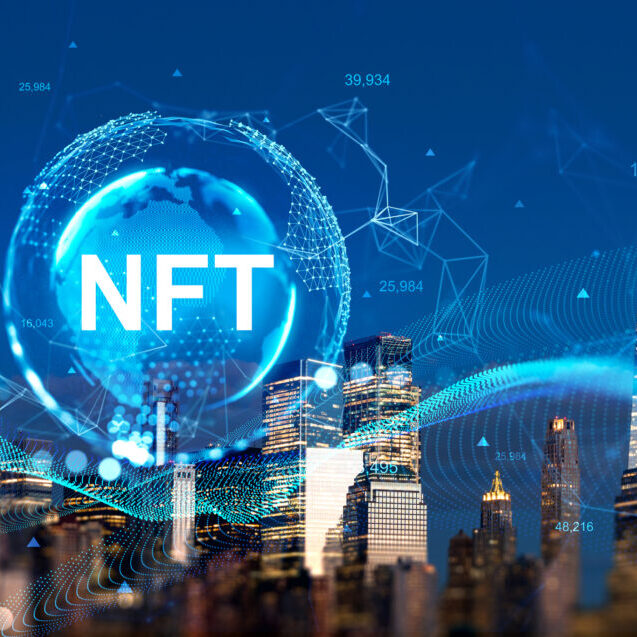Insights < BACK TO ALL INSIGHTS
Ifrah Law at NFT.NYC: Web3 Gaming’s Growing Pains and Maturity
Ifrah Law at NFT.NYC: Web3 Gaming’s Growing Pains and Maturity
By: Jake Gray
From April 12th to April 14th, NFT.NYC held its fourth inaugural event since its launch in 2019, boasting more than 1,500 speakers across seven different categories and a featured section. Moving from an array of venues spread throughout Times Square to a centralized location North Javits, Hudson Yards, the event was significantly less well attended than the previous year. Official attendance numbers have not been released, but estimations before the event suggested around 6,000, attendees, less than half of 2022’s 15,000 attendees.
The NFT industry has limped alongside the cryptocurrency industry since the outset of the cryptocurrency recession, which came into full effect in the middle of last year amid global recession worries and a host of crypto-exchange implosions.[1] CoinDesk recently published an article covering the data; it shows that the numbers of unique traders on various NFT marketplaces have been steadily declining since their peak at the tail-end of 2021 and the beginning of 2022.[2] While numbers have dwindled, what remains is a leaner industry, more adequately equipped for sustained growth.
Indeed, a rather optimistic sentiment was reflected in the various talks concerning Web3 gaming at NFT.NYC, as companies discussed not only the ways in which to survive the crypto winter but methods to flourish beyond it.
Web3 Gaming Industry Concerns
The prevailing thought underlying much of the NFT.NYC’s gaming discussions was that Web3 users and enthusiasts are “here to stay,” as evinced by the very survival of the project through the trials and tribulations during the crypto-winter. As a result, Web3 gaming companies have started to focus on a new goal: acquiring new Web2 users rather than competing for the attention of Web3 enthusiasts.
Keenly aware of the fact that Web2 gamers have largely resisted Web3 integrations into gaming and blockchain products more generally, the largest concern for Web3 gaming companies is identifying the cause of such opposition as well as overcoming it. As one panelist put it, “what will it take to get someone enthralled in your game, in spite of their knee-jerk opposition to Web3?”
Let’s cover a few of the self-identified causes discussed in NFT.NYC panels, and then we’ll cover some of the potential solutions that are part of a broader approach.
The first is poor game design. Generally speaking, prior to the crypto-winter, the broader blockchain sub-industries suffered from an over-saturation of companies and consumers alike trying to capitalize on hype and speculation to make a quick profit. The result was that companies would either create small economic ecosystems with games attached to them, or hastily throw together minimally viable products to satisfy customers, after they had already purchased various promotional products from the company. For instance, many Web3 games would privilege play-to-earn mechanisms so users could increase the value of their NFTs (or attain new ones) and sell them for a profit. Instead of a game wherein a player could incidentally earn money, many of the players were only there to earn money and it just happened to be by means of a game. So, once the crypto-winter came, those users left and the industry suffered as a whole. As one panelist noted, “the typical player is not selecting their game on their ability to earn money, they are doing so on the basis of fun. If the game is fun, people will play it, Web3 or otherwise.”
Second is the NFT reputation problem. Any negative press harmful to the reputation of Web3 and blockchain technologies, such as cryptocurrency and crypto exchanges, for example, is often implicitly applied to the other sub-industries. So, in the midst of news covering various cryptocurrency rug pulls, scams, and hacks in the nascent stages of the industry, the reputation of NFTs as both an industry and technology were harmed in the process. Beyond fraud concerns, most, if not all, of the positive NFT press typically covered massive gains NFT holders had seen when the markets experienced explosive growth. As, such a poor picture was painted to those unaffiliated with blockchain and Web3, a picture that made them not only unaffiliated and uninterested, but actively opposed to its wide-spread use and adoption: NFTs seemed to be just another means to make money. So, when AAA gaming companies came knocking on Web3’s doors, many Web2 gamers and developers pushed back against what appeared to them as corporate greed.
This sentiment was palatable to many of the panelists, as they expressed discontent with much of the publicity the Web3 industry had received over the last year and how it harmed serious gaming companies not at all interested in capitalizing on consumer speculation and hype: “It’s frustrating to see what is assumed about Web3 companies, gaming ones especially. We love our players and want to give them a great game more than anything, not provide them a method to gamble on NFT purchases for a quick turnaround. That’s not what we’re doing because that’s not what gaming is.” Legitimate Web3 gaming companies are now stuck with a poor reputation by association, one which they’re working hard to overcome.
The third issue is the various barriers to entry of Web3 games. As we just discussed, and as many panelists expressed, not everyone is enthused about Web3 technology and its potential benefits to gaming. Indeed, many may not even understand what Web3 actually is. Thus, asking faintly interested Web2 gamers to play a Web3 game comes with two significant barriers to entry, one of knowledge and one of action, apart from the other issues. First, in order to effectively play the game (and stay playing the game), players need to understand the various mechanisms by which the game operates, many parts of which include blockchain technology, NFTs, wallets, tokens, and so on. Similarly, users need to be willing to, at a bare minimum, make a wallet and proceed from there if primarily NFT-based. While the issue seems small, the process can be intimidating, and some may find the process tedious altogether and forego it for what they know (e.g. Web2 games). Although minuscule at first glance, once conjoined with the others, the issue becomes evidently more detrimental to a game’s success.
A New Approach to Mainstream Adoption: Web2.5 Gaming
Substantial growing pains have afflicted the Web3 industry since 2022’s NFT.NYC, pains which have accompanied maturation of company strategy and outlook. Last year, many of the discussions revolved around monetization methods and play-to-earn models alongside general praise of the purported technological innovations in the industry. This year, companies hard-pressed the emergent issues outright, rather than faintly alluding to them, in an effort to overcome them together.
A novel, synthesized approach to the issues cited above is the notion of what can be called “Web2.5” gaming. This term can be defined to mean, roughly, games that either optionally or subtly rely on incremental aspects of blockchain technology in the creation of features for an in-game ecosystem. The approach consists, potentially, of a few different components, all of which are tailored to tackle the issues described above.
The first component consists in minimizing the technical descriptions of the Web3 components of the game. The historical approach has been to advertise the game as a Web3 game, rather than just a game. In other words, Web3 was historically front and center rather than the game itself. As one panelist put it, “when you’re playing WoW you don’t refer to the fact that you’re playing on TCP/IP, you say you’re playing through the Internet—in fact, you don’t even think about the fact that you’re using the Internet to play or that it’s an MMORPG, you just play.” Implicit in this approach is the understanding that (most) gamers don’t really care about the underlying technology supporting the game in itself; gamers care about the experience. So, by minimizing the technical Web3 descriptions, companies can obviate the NFT reputation problem by being a credible gaming company. It’s a user-first rather than an NFT-first approach.
Supplementary to this rhetorical component is a second component—a practical one—that attempts to remove or chip away at the barriers-to-entry. As discussed in our series on Web3, Web3 gaming necessarily relies upon NFTs to be Web3, but need not necessarily do so to be a game, hence the name “Web2.5.” Some companies now either optionally require users to have a wallet to play the game or employ a frictionless process for creating and maintain one. Immutable X, in partnership with Magic, for instance, recently created a password-less login and authentication to “elimin[ate] friction and remov[e] complexity in onboarding user experience.” [3] Similarly, minting in-game items onto the blockchain may not always be required, though it would be required if users were interested in selling their items on a secondary marketplace for money. The same can be said of wallets—if users are interested in trading in-game items for money with other players, they’ll need a wallet. In effect, this component makes the Web3 aspect barely noticeable: “the point is to onboard people and then educate them about Web3, not the other way around.”
The concomitant effect of making such features optional is that gameplay rather than economic opportunity is (or should be) emphasized, both on the user and developer side. Since not all the game’s players may be interested in Web3, game developers are forced to concentrate on how enjoyable the game is. As one panelist stated, “the game speaks for itself when you pour all your energy into it and the community and what the community wants out of the game. Good Web3 games are good games first.” Additionally, panelists mentioned that companies should actively work to prevent speculation, by not hyping up massive sales of NFT in-game items, and instead, opting to let the game economy run itself: “there should be no expectation that your users spend money on NFTs, just that they are a part of the broader community. If they’re invigorated by game and community, the sales will come.”
Conclusion
Despite an array of setbacks for the broader blockchain and Web3 industry, the NFT space has shown an abundance of determination to grow into a substantial tech industry beyond the hype of years past. In fact, the setbacks have proved instructive in guiding the industry toward strategies for achieving sustained growth. As we’ve seen in the case of Web3 gaming discussions at NFT.NYC, the industry is here to stay, having seized the opportunity presented by the crypto-winter period to refine their products for consumption by a wider audience.
[1] https://newsdirect.com/news/nft-sales-drop-83-in-a-year-2-37bn-drop-in-revenue-303243772
Related: Sports Betting Lawyers





